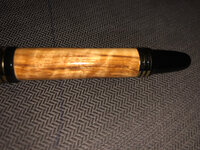Greetings all 
Periodically I get marks on my pens that I think are turning marks, but I'm not sure. The attached photo shows a typical example. They aren't actually as obvious as they look in the photo, I had to mess around a little with the light to "enhance" them.
The reason I'm not absolutely certain if they're turning marks is that they are at an angle. I turn fast (now) and shave the wood gently, but can't see how that motion causes marks at that angle. However, I can't think what else they could be. Doesn't happen often but is really annoying when it does. Some woods, like with the olive here, seem more susceptible than others I think. Also, these can't be seen at all until I start to apply the CA, or something like an alcohol clean before that evaporates. Sanding doesn't seem to help either, and they can't actually be felt.
Thoughts and any advice? I'm a bit lost on this one.
Thanks
Periodically I get marks on my pens that I think are turning marks, but I'm not sure. The attached photo shows a typical example. They aren't actually as obvious as they look in the photo, I had to mess around a little with the light to "enhance" them.
The reason I'm not absolutely certain if they're turning marks is that they are at an angle. I turn fast (now) and shave the wood gently, but can't see how that motion causes marks at that angle. However, I can't think what else they could be. Doesn't happen often but is really annoying when it does. Some woods, like with the olive here, seem more susceptible than others I think. Also, these can't be seen at all until I start to apply the CA, or something like an alcohol clean before that evaporates. Sanding doesn't seem to help either, and they can't actually be felt.
Thoughts and any advice? I'm a bit lost on this one.
Thanks

